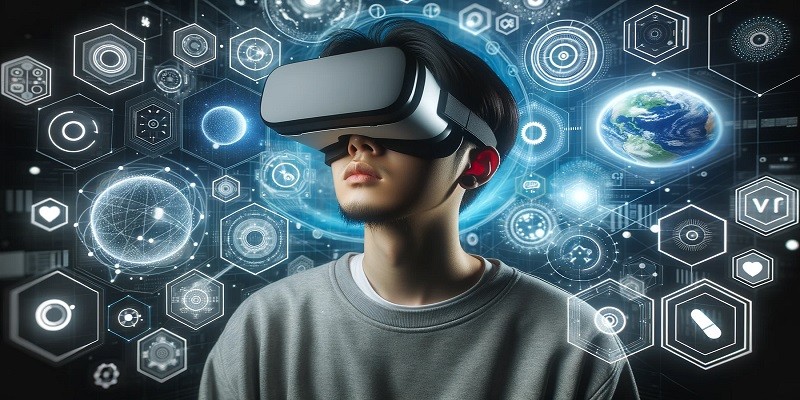Virtual Reality: Bridging the Gap Between Digital And Physical Worlds
Virtual Reality bridges the gap between the digital and physical worlds, offering a transformative experience that immerses users in a simulated environment. This cutting-edge technology has the potential to revolutionize various industries and reshape our everyday lives.
Whether it’s in gaming, education, healthcare, or even architecture, Virtual Reality enables us to interact with artificial environments in a profoundly realistic and interactive way. By leveraging high-quality visuals, realistic sound effects, and intuitive user interfaces, Virtual Reality creates a sense of presence that blurs the boundaries between what is real and what is virtual.
We will explore the incredible potential of Virtual Reality and how it is reshaping our perception of reality.
The Evolution Of Virtual Reality

Virtual Reality (VR) has come a long way in bridging the gap between the digital and physical worlds. The evolution of VR technology has revolutionized how we interact with the digital realm, offering immersive experiences like never before.
Read More – Renewable Energy Tech: How Solar Panels are Becoming More Efficient
Early Development
In the early stages, virtual reality was a concept explored mostly in science fiction. However, the development of VR dates back to the 1950s when innovators began to experiment with creating simulated environments.
Technological Advancements
Technological advancements have played a significant role in the evolution of VR. The introduction of powerful graphic processors and advanced sensors has enabled more realistic and engaging virtual experiences.
Virtual Reality In Various Industries
Virtual Reality (VR) has become more than just a gaming phenomenon; it is now bridging the gap between the digital and physical worlds in various industries. With its ability to create immersive and interactive experiences, VR is transforming how we approach healthcare, entertainment, and education.
Healthcare
In the healthcare industry, Virtual Reality is revolutionizing patient care by providing innovative solutions for both diagnosis and treatment. VR simulations allow medical professionals to practice complex procedures in a safe and controlled environment, eliminating the risk of mistakes during real-life surgeries. Patients can also benefit from VR therapy, which helps alleviate pain, reduce anxiety, and even treat phobias. Through VR, healthcare professionals can provide personalized and immersive experiences that enhance patient well-being and improve overall medical outcomes.
Read More – Cybersecurity in the Age of IoT: Protecting Your Digital Footprint
Entertainment
Virtual Reality has transformed the entertainment industry, offering users an unprecedented level of immersion and engagement. With VR headsets, people can step into virtual worlds where they can actively participate in their favorite movies, games, and sports. From thrilling virtual roller coasters to virtual concerts where users can interact with their favorite artists, the possibilities are endless. VR is elevating the entertainment experience by blurring the boundaries between reality and fantasy, enabling users to explore new realms and unleash their creativity.
Education
The potential of Virtual Reality in education is immense, as it allows students to transcend the constraints of traditional learning environments. Through immersive experiences, students can visit historical landmarks, explore distant galaxies, or even dive into the human body. VR enhances engagement and retention as it creates a multisensory learning environment that stimulates visual, auditory, and tactile senses. With VR, education becomes more interactive and dynamic, promoting critical thinking, problem-solving, and creativity. Virtual Reality is bridging the gap between the physical and digital worlds, offering endless educational possibilities.
Challenges And Limitations
Virtual reality has rapidly advanced in bridging the gap between the digital and physical worlds. However, challenges and limitations still hinder its widespread adoption. Issues like motion sickness, high costs, and hardware limitations pose obstacles to achieving seamless integration. Nonetheless, continued innovation and development offer hope for overcoming these barriers.
Virtual Reality (VR) has the potential to revolutionize the way we interact with digital content and bridge the gap between the digital and physical worlds. However, this exciting technology also comes with its fair share of challenges and limitations that need to be addressed for its widespread adoption. In this article, we will explore some of the key challenges and limitations of VR, including technical constraints and ethical considerations, and discuss their implications for the future of this immersive technology.
Read More – Simple Tips to Improve Your Website’s SEO with Smart Linking
Technical Constraints
Virtual Reality experiences rely on complex technological systems that can sometimes pose limitations in providing a seamless and realistic immersive environment. Some of the common technical constraints of VR include:
- Hardware Requirements: VR experiences often require powerful computer systems or dedicated VR headsets with high-end specifications, limiting accessibility for some users.
- Processing Power: Rendering realistic 3D environments in real time demands significant processing power, which can lead to lag or a decrease in image quality.
- Physical Discomfort: Extended use of VR can cause motion sickness or discomfort due to the disparity between the sensory inputs from the virtual world and the physical body.
- User Interface Design: Designing intuitive and user-friendly interfaces for VR applications can be a challenge, as traditional input methods may not translate effectively in a fully immersive environment.
- Content Development: Creating high-quality VR content requires specialized skills and resources, making it time-consuming and expensive for content creators.
Ethical Considerations
Adopting VR technology also raises important ethical considerations that need to be addressed. These considerations include:
- User Privacy: VR systems collect a vast amount of personal data, including user behavior and preferences. Safeguarding this data and ensuring user privacy becomes crucial to maintaining user trust.
- Virtual Harassment: Virtual environments can be susceptible to harassment and bullying, necessitating the development of systems to prevent and address such issues.
- Impact on Physical and Mental Health: Prolonged exposure to VR can have potential effects on physical health, such as eye strain and muscle fatigue, as well as mental health, including issues like addiction or dissociation.
- Virtual Property and Rights: As virtual economies and marketplaces emerge, issues related to ownership and intellectual property rights within these digital spaces need to be carefully regulated.
- Real-World Interaction: Spending excessive time in VR can have implications for real-world social interactions, leading to isolation or withdrawal from physical social experiences.
In conclusion, as Virtual Reality continues to evolve and gain prominence in various fields, it is important to recognize and address the challenges and limitations associated with this immersive technology. By overcoming technical constraints and wisely navigating ethical considerations, we can ensure a safer and more inclusive VR experience that truly bridges the gap between the digital and physical worlds.
The Future Of Virtual Reality
The Future of Virtual Reality is advancing rapidly, pushing the boundaries of digital experiences. Let’s delve into the latest innovations shaping this exciting sphere.
Advancements In VR Technology
Virtual Reality technology continues to evolve, enhancing immersion and realism. Smaller headsets and improved graphics are on the rise.
Integration With Ar And Mr
Augmented Reality (AR) and Mixed Reality (MR) are merging with VR, creating hybrid experiences that blend digital and physical worlds seamlessly.
Frequently Asked Questions
What Is Virtual Reality And How Does It Work?
Virtual reality is a computer-generated simulation that immerses users in a fabricated environment, typically through the use of special headsets and sensory devices.
What Are The Practical Applications Of Virtual Reality?
Virtual reality is being used in various industries, such as healthcare, education, and entertainment, to simulate real-life experiences, training scenarios, and immersive storytelling.
How Does Virtual Reality Enhance User Experiences?
Virtual reality enhances user experiences by providing a heightened sense of immersion, interactivity, and presence, enabling users to engage with digital content in new and exciting ways.
What Are The Potential Challenges Of Virtual Reality Technology?
Challenges of virtual reality technology include issues related to motion sickness, limited content availability, and the high cost of quality VR hardware and software.
How Is Virtual Reality Shaping The Future Of Digital Interaction?
Virtual reality is revolutionizing digital interaction by bridging the gap between physical and digital worlds, offering unparalleled opportunities for communication, collaboration, and exploration.
Conclusion
Virtual reality immersive experiences are reshaping the way we interact with digital content. As technology advances, the divide between the virtual and physical worlds narrows, offering endless possibilities. Embrace this innovative bridge to transform how we learn, entertain, and connect in a hyper-connected society.

